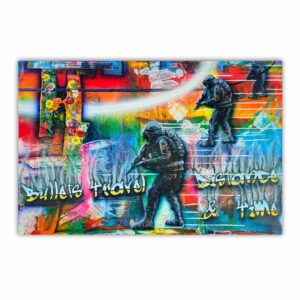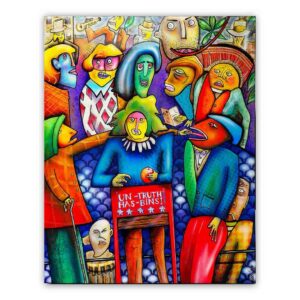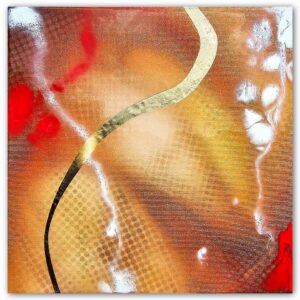- [email protected]
- +353 (0)86 224 0139
- Free Shipping Worldwide
Influence of Cultural Identity on African Art
Does Cultural Identity Influence the Creation of Art? In the first region of this series, we explore the magnificent continent of Africa.
Reading Time: 15 minutes
TL;DR
- Discover the hidden stories behind African art and how cultural identity breathes life into each masterpiece.
- Uncover the mesmerising fusion of traditions and modern influences in African art, resulting in captivating and unique styles.
- Explore the profound connection between cultural identity and the artistic expression of Africa, and be inspired to own a piece that embodies this rich heritage.
Traditional African Art
Africa’s art may appear complex, but it is a truly simple masterpiece. Before we get into how cultural identity has influenced African art, let me take you back to the beginning. For obvious reasons, culture and art are among Africa’s most valuable assets.
Many different religions are practised on the continent. African art, in addition to prehistoric and ancient art, includes Islamic objects from North and West Africa, as well as Christian items from East Africa. This includes artefacts from these areas as well as tribes with distinct rituals and beliefs.
Every culture includes the arts, literature, music, and social behaviour. Some may be small in comparison to the number of people associated with and belonging to a culture. However, the worth of a particular culture cannot be measured in terms of size. Every culture, no matter how small or large, has a unique contribution to art.
In light of this, please read on as we consider the following ten ways in which cultural identity has influenced African art.
“Artists reach areas far beyond the reach of politicians. Art, especially entertainment and music, is understood by everybody, and it lifts the spirits and the morale of those who hear it.”
Nelson Mandela
African Art & Cultural Identity
African cultures, in addition to being the second most populous continent on the planet, have played an important role in human history for thousands of years.
Africa has a rich cultural history that has been passed down through the centuries. Some of its natural beauty has gradually faded into the soil, hidden beneath the sands of time. For instance, the remains of, among other things:
- Pyramids of Giza, Egypt
- Adam’s Calendar, South Africa
- Khami Ruins, Zimbabwe
- Kilwa Kisiwani, Tanzania
- Luxor Temple, Egypt
- Gedi Ruins, Kenya
- Nok Caves, Togo
- Volubilis, Morocco
True African art cannot be captured in an image or photograph, no matter how hard some may try. Although not all African art is tribal, it is best known for its bright colours, distinctive complex designs/patterns, and stunning images due to its tremendous diversity and different languages spoken across the continent.
There was a time when the art market was considered fair game for certain types of artefacts, with pieces freely flooding auction houses and western museums from abroad.
Changing attitudes and an ivory ban have made it more difficult than ever for dealers to buy and sell ivory, despite the fact that there are no real “holds” on trading Africa’s cultural identity itself.
Cultural identity is typically defined as the act of self-identification with a specific ethnic group. Nonetheless, the purpose of this article is to describe how self-identification with an ethnic group has influenced African artwork.
10 Ways Cultural Identity Has Influenced African Art
Africa’s rich cultural heritage is deeply reflected in African art, from traditional to modern. The following are ten ways that cultural identity has shaped the course of African art.
1. Historical Connection
African art is always an expression of a story in relation to its predecessors. African art originated as one of the earliest forms of communication and was documented long before history. The Nassarius’ beads , for example, were worn as personal ornaments nearly 72,000 years ago.
The beads were discovered in Blombos Cave in South Africa and were made from Nassarius shells, a small species of sea snail found in the Indian Ocean and the Mediterranean Sea. Humans altered the shells with flint tools. Archaeologists believe such shells were used as body ornamentation, necklaces, or to make fish hooks.
Furthermore, African tribal art serves as historical reservoirs in the process of cultural identity formation.
As a result, an artist can now use their work to identify with the culture, thereby shaping African contemporary artwork.
2. Materials Used in African Art
African artists use a variety of materials, including silver, gold, copper, brass, ivory, wood, clay, animal skin, textiles, and beads.
Changing attitudes and an ivory ban have made it more difficult than ever for dealers to buy and sell ivory, despite the fact that there are no real “holds” on trading Africa’s cultural identity itself.
Cultural identity, particularly the intentional creation of art, fosters a connection to one’s roots.
Africa remains a continent with vast reserves of minerals such as bronze, gold, silver, and many others. African countries assist their artisans in designing and creating jewellery that incorporates such elements to express their cultures.
Let us look at the Kente to put this idea into context. Kente is a traditional handwoven cloth with silk and cotton texture. The fabric is typically centred on Ghanaian culture. The Kente is a warp that is worn in a toga-like fashion by both men and women in their culture.
Overall, there are several differences in the fabrics from gender to gender. Above all, each colour represents a distinct meaning. With this in mind, an artist who wishes to identify with their Ghanaian roots could draw inspiration from the Kente, and create outstanding African tribal artwork that speaks directly to your emotions. Furthermore, the same artist may use sisal and cotton to richly express the Kente inspiration.
3. The Diverse Cultures of Africa
African culture employs a variety of expression forms, such as dance, music, clothing, cuisine, and languages. To identify with a specific culture, you must first understand the community’s norms. These practises foster a personalised connection between members of the community. Furthermore, cultural practises differ from one community to the next.
Traditional dances in the Egyptian community, for example, are very different from traditional dances in the Zulu community. The Egyptian community dance dates back to antiquity, and the movements are depicted in many wall paintings.
Dancing was an important part of the ancient Egyptians’ lives. However, men and women are never depicted dancing together, which was a prominent feature of Egyptian dancing.
An Egyptian artist attempting to identify with his or her culture may depict these dances in their artwork to create a masterpiece.
4. Human Figure Emphasis
The human figure has, without a doubt, always been an important subject in African art. Furthermore, this factor has influenced European traditions. The human figure in an African context may represent a living or deceased chief, dancer, drummer, or even hunter. Furthermore, some tribes use symbolism to represent a saviour or god in their community.
I have recently become fascinated by the Dogon (or Kaador, Kaado), an indigenous people of central Mali, West Africa. Located near Bandiagara in Burkina Faso, south of the Niger bend.
Dogon artists frequently create figurative sculptures with raised arms. Dongon art is inspired by religious values, ideals, and liberties. Dogon sculptures are not intended for public viewing. Instead, they are kept in homes, shrines, or with the Hogon, the village’s spiritual leader. Because of the symbolic meaning behind the pieces and the process by which they are created, secrecy is essential.
Traditional Dogon religion contains information about extrasolar astronomical bodies that are not visible to the naked eye. Sirius (Sigi Tolo or Sigui star) has two companion stars, the Digitaria star (Pō Tolo) and the female Sorghum star (ęmmę ya tolo). This has led to the theory that in the distant past, extraterrestrial life visited Mali and imparted knowledge.
Artists use the human figure emphasis in their specific cultures or subject cultures to create art that represents that specific community through cultural identity. As a result, the cultural emphasis on the human figure has a direct influence on African art.

5. African Art: Colour Symbolism
In terms of style, delivery, and inspiration, African art is diverse. However, the majority of African artwork uses colour to convey symbolism. African tribal art, primarily sculptures, is steeped in symbolism. That is, the palette used in the drawing has more meaning than its overall appearance.
The colour is intended to communicate directly with your soul. For example, the colour red conveys danger, energy, urgency, or daring! With this in mind, the colour can be used to depict specific emotions in contemporary African artwork.
"In a moment of crisis, the wise build bridges and the foolish build dams."
Nigerian Proverb
6. What Are Some of The Ways African Art Connects the Real World with the Spiritual World?
African religion and folklore, like all human cultures, are varied and diverse. In addition, spirituality and culture coexist and are intertwined in most African cultures. The majority of these African cultural-religious beliefs about the spirit world are depicted in contemporary and traditional artworks.
In fact, artistic abilities are thought to please higher spirits in some cultures. Paintings, statues, masks, and sculptures are examples of common artworks depicting African religious beliefs. These statues and sculptures serve as a conduit for communication with the spiritual forces.
For example, in the Kingdom of Kongo, people believed that certain art objects known as Nkisi were inhabited by spirits. As a result, the Nkisi is frequently carved into the shapes of animals or even humans as power objects today. This particular work of art is used to identify with and communicate with the spirit world.
7. Story Telling
Storytelling has always been an important part of African society. Africans had a voracious appetite for stories long before written texts were possible. It was also a means of instilling moral values in the youth.
Most African cultures took this element a step further by incorporating storytelling into their art. We have learned a lot about African heritage through paintings as a result of that. Most artists will use paint to tell stories in order to bring their African artwork to life.
8. Contemporary African Artwork
Perhaps this is one of the most frequently misunderstood concepts in both the African diaspora and among Africans in general. Contemporary African art began where colonialists first arrived in Africa. Contemporary African artwork, according to a more modern definition, is African art that has conquered and is accepted by Western culture.
Traditional African art evolved into contemporary African art, which shares many features with its forebears. However, because it is primarily an art interpretation with a touch of African cultural identity, it has had a huge impact.
Africans in the diaspora, on the other hand, are more inclined to create contemporary African art in order to reconnect with their roots.
9. Animal Symbolism
Individual animals in African culture have distinct characteristics, such as snakes, leopards, antelopes, and crocodiles. As a result, such animals will always be represented in African culture art for specific purposes.
In the nineteenth century, the Fon King Guezo was always depicted as a buffalo. A buffalo is a symbol of both strength and determination in African culture. The emblem is chosen using the Fa divination, which predicts the character and nature of the King’s reign.
Different animal features may be combined into new forms in some African cultural art forms. Nowadays, this type of art is used to represent more complex ideas. In other cases, animal depictions in artwork depict individuals consuming others. This type of African artwork could be interpreted as a metaphor for the union of social and spiritual forces. Such forms of art attempt to demonstrate how to resolve specific difficult social encounters.
10. Express Individualism
Last but not least is the concept of expressing individualism through art. In the West, there is a strong emphasis on expressing individualism in art, which influences how your work will look in comparison to your predecessors.
So, as much as a young artist wishes to express their connection to African art, the art must always be different due to Western cultural influence. This has a significant impact on African art whenever an artist attempts to identify with a specific African style.

Conclusion: Culture and African Artistic Expression
I hope you found my blog post about cultural identity and African art interesting. Culture and art are inextricably linked in many ways and have always been an important part of African life.
In this post, I hoped to offer a fresh perspective on the regions creativity and innovation. Furthermore, many people may not realise how influential the continent has been in the advancement of culture around the world.
From traditional African masks to contemporary pieces, we will gain a better understanding of African cultural identity today.
Can I Create an African Art Masterpiece?
Why can’t I make a masterpiece like this? Many people are not sure whether they can create an African artwork, but with some guidance, anything is possible.
There are several ways you can do this, and each of them has pros and cons. You can sketch out the design by hand on paper, which is time-consuming and requires more skill than painting, but does allow for more flexibility.
Of course, yes! All you have to do is draw inspiration from a given culture, item, or religious belief and explore your creative nature.
However, if you have any trouble with your work, Ren Creative Works is here to assist you. I can offer you bespoke services to design your perfect African tribal inspired artwork.
If you have enjoyed reading about the Influence of Cultural Identity on African Art, I invite you discover the cornerstone article to this series: The Influence of Cultural Identity on the Creation of Art, and other regions of the world by clicking on the links below:
- 10 ways cultural identity has influenced Asian Art
- 10 ways cultural identity has influenced Caribbean Art
- 10 ways cultural identity has influenced European Art
- 10 ways cultural identity has influenced North America’s Art
- 10 ways cultural identity has influenced South America’s Art
- 10 ways cultural identity has influenced Oceania Art
- Famous Irish Art and Cultural Identity
If you enjoyed this article, please subscribe to my mailing list and share it with your friends, family, and business associates if you think they would be interested. As an independent artist, this kind of support is invaluable.
The time you spent reading this blog is greatly appreciated. Thank you.
Adrian Reynolds, or ‘Ren,’ is a Dublin-based contemporary artist. His works are a reaction to the world around us. A world that continues to evolve quicker than ever. His work investigates colour, form, and texture, putting them at the intersection of abstraction and representation. His art has been shown in Ireland, the United Kingdom, and the United States.
Latest Artwork
-
Bullets Travel Distance & Time
Abstract Art Paintings €1,000.00Add to basketBullets Travel Distance & Time | Acrylic Painting By Adrian Reynolds
-
The Perception of Narrative
Abstract Art Paintings €800.00Add to basketThe Perception of Narrative | Fine Art Acrylic Painting By Adrian Reynolds
-
Iridescent Dream
Abstract Art Paintings €240.00Add to basketIridescent Dream | Acrylic Painting By Adrian Reynolds
-
Blue Nebula
Abstract Art Paintings €240.00Add to basketBlue Nebula | Acrylic Painting By Adrian Reynolds



